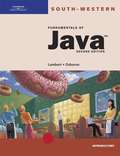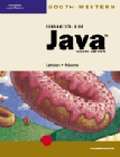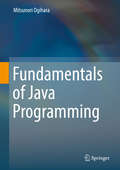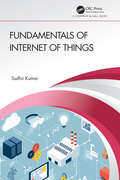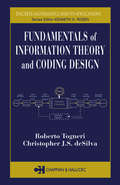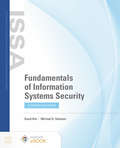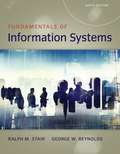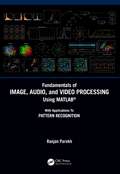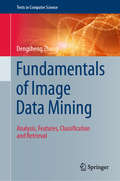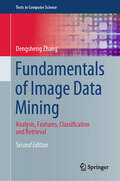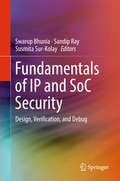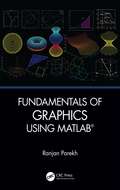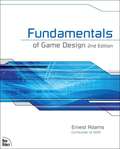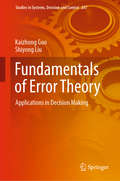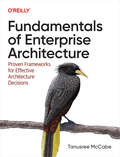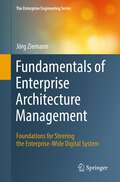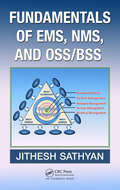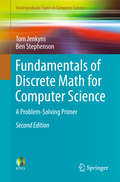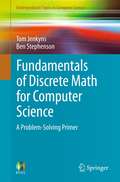- Table View
- List View
Fundamentals of Java: Introductory Course (2nd Edition)
by Kenneth Lambert Martin OsborneCompletely revised and updated, Fundamentals of Java: Introductory Course, Second Edition now covers all of the AP requirements for Computer Science Exam A. Clear, practical explanations guide students through even the most complex programming topic. Since it is non-software specific, it can be used with any Java program compiler, including Borland, Sun Microsystems, Symantec and others.
Fundamentals of Java: Comprehensive Course
by Kenneth Lambert Martin OsborneCompletely revised and updated, Fundamentals of Java: Comprehensive Course covers all of the AP requirements for Computer Science Exams A and AB. By taking a multilevel approach to teaching Java, this text is suitable for a wide range of students, from beginners to those ready for advanced data structures. Since it is non-software specific, it can be used with any Java program compiler, including Borland, Sun Microsystems, Symantec and others.
Fundamentals of Java Programming
by Mitsunori OgiharaMaking extensive use of examples, this textbook on Java programming teaches the fundamental skills for getting started in a command-line environment. Meant to be used for a one-semester course to build solid foundations in Java, Fundamentals of Java Programming eschews second-semester content to concentrate on over 180 code examples and 250 exercises.Key object classes (String, Scanner, PrintStream, Arrays, and File) are included to get started in Java programming. The programs are explained with almost line-by-line descriptions, also with chapter-by-chapter coding exercises.Teaching resources include solutions to the exercises, as well as digital lecture slides.
Fundamentals of Internet of Things for Non-Engineers (Technology for Non-Engineers)
by Ronald J. Kovac Rebecca Lee HammonsThe IoT is the next manifestation of the Internet. The trend started by connecting computers to computers, progressed to connecting people to people, and is now moving to connect everything to everything. The movement started like a race—with a lot of fanfare, excitement, and cheering. We’re now into the work phase, and we have to figure out how to make the dream come true. The IoT will have many faces and involve many fields as it progresses. It will involve technology, design, security, legal policy, business, artificial intelligence, design, Big Data, and forensics; about any field that exists now. This is the reason for this book. There are books in each one of these fields, but the focus was always "an inch wide and a mile deep." There’s a need for a book that will introduce the IoT to non-engineers and allow them to dream of the possibilities and explore the work venues in this area. The book had to be "a mile wide and a few inches deep." The editors met this goal by engaging experts from a number of fields and asking them to come together to create an introductory IoT book. Fundamentals of Internet of Things for Non-Engineers Provides a comprehensive view of the current fundamentals and the anticipated future trends in the realm of Internet of Things from a practitioner’s point of view Brings together a variety of voices with subject matter expertise in these diverse topical areas to provide leaders, students, and lay persons with a fresh worldview of the Internet of Things and the background to succeed in related technology decision-making Enhances the reader’s experience through a review of actual applications of Internet of Things end points and devices to solve business and civic problems along with notes on lessons learned Prepares readers to embrace the Internet of Things era and address complex business, social, operational, educational, and personal systems integration questions and opportunities
Fundamentals of Internet of Things
by Sudhir KumarThe Internet of Things (IoT) networks have revolutionized the world and have innumerable real-time applications on automation. A few examples include driverless cars, remote monitoring of the elderly, remote order of tea or coffee of your choice from a vending machine, and home/industrial automation amongst others. Fundamentals of Internet of Things build the foundations of IoT networks by leveraging the relevant concepts from signal processing, communications, net-works, and machine learning. The book covers two fundamental components of IoT networks, namely, the Internet and Things. In particular, the book focuses on networking concepts, protocols, clustering, data fusion, localization, energy harvesting, control optimization, data analytics, fog computing, privacy, and security including elliptic curve cryptography and blockchain technology. Most of the existing books are theoretical and without many mathematical details and examples. In addition, some essential topics of the IoT networks are also missing in the existing books. Features: • The book covers cutting-edge research topics• Provides mathematical understanding of the topics in addition to relevant theory and insights• Includes illustrations with hand-solved numerical examples for visualization of the theory and testing of understanding• Lucid and crisp explanation to lessen the study time of the reader The book is a complete package of the fundamentals of IoT networks and is suitable for graduate-level students and researchers who want to dive into the world of IoT networks.
Fundamentals of Information Theory and Coding Design (Discrete Mathematics and Its Applications)
by Roberto Togneri Christopher J.S deSilvaBooks on information theory and coding have proliferated over the last few years, but few succeed in covering the fundamentals without losing students in mathematical abstraction. Even fewer build the essential theoretical framework when presenting algorithms and implementation details of modern coding systems.Without abandoning the theoret
Fundamentals of Information Systems Security
by David Kim Michael G. SolomonFundamentals of Information Systems Security, Fourth Edition provides a comprehensive overview of the essential concepts readers must know as they pursue careers in information systems security.
Fundamentals of Information Systems
by Ralph Stair George ReynoldsGain an overview of the core principles of IS and how it is practiced today as the concise, nine-chapter FUNDAMENTALS OF INFORMATION SYSTEMS, 9th edition combines the latest research with the most current coverage available. The book addresses analytics; big data; business intelligence; cloud computing; cybercrime and information system security; e-commerce; enterprise systems; ethical, legal, and social issues of information systems; mobile computing solutions; and systems acquisition and development. You learn how information systems can increase profits and reduce costs as you explore the latest information on artificial intelligence, change management, consumerization of information systems, data governance, energy and environmental concerns, global IS challenges, Internet of Everything, Internet censorship and net neutrality, IS careers, and virtual teams. Leading online MindTap help you further maximize success as an employee, decision maker, and business leader.
Fundamentals of Image, Audio, and Video Processing Using MATLAB®: With Applications to Pattern Recognition
by Ranjan ParekhFundamentals of Image, Audio, and Video Processing Using MATLAB® introduces the concepts and principles of media processing and its applications in pattern recognition by adopting a hands-on approach using program implementations. The book covers the tools and techniques for reading, modifying, and writing image, audio, and video files using the data analysis and visualization tool MATLAB®. Key Features: Covers fundamental concepts of image, audio, and video processing Demonstrates the use of MATLAB® on solving problems on media processing Discusses important features of Image Processing Toolbox, Audio System Toolbox, and Computer Vision Toolbox MATLAB® codes are provided as answers to specific problems Illustrates the use of Simulink for audio and video processing Handles processing techniques in both the Spatio-Temporal domain and Frequency domain This is a perfect companion for graduate and post-graduate students studying courses on image processing, speech and language processing, signal processing, video object detection and tracking, and related multimedia technologies, with a focus on practical implementations using programming constructs and skill developments. It will also appeal to researchers in the field of pattern recognition, computer vision and content-based retrieval, and for students of MATLAB® courses dealing with media processing, statistical analysis, and data visualization. Dr. Ranjan Parekh, PhD (Engineering), is Professor at the School of Education Technology, Jadavpur University, Calcutta, India, and is involved with teaching subjects related to Graphics and Multimedia at the post-graduate level. His research interest includes multimedia information processing, pattern recognition, and computer vision.
Fundamentals of Image Data Mining: Analysis, Features, Classification and Retrieval (Texts in Computer Science)
by Dengsheng ZhangThis reader-friendly textbook presents a comprehensive review of the essentials of image data mining, and the latest cutting-edge techniques used in the field. The coverage spans all aspects of image analysis and understanding, offering deep insights into areas of feature extraction, machine learning, and image retrieval. The theoretical coverage is supported by practical mathematical models and algorithms, utilizing data from real-world examples and experiments.Topics and features: describes the essential tools for image mining, covering Fourier transforms, Gabor filters, and contemporary wavelet transforms; reviews a varied range of state-of-the-art models, algorithms, and procedures for image mining; emphasizes how to deal with real image data for practical image mining; highlights how such features as color, texture, and shape can be mined or extracted from images for image representation; presents four powerful approaches for classifying image data, namely, Bayesian classification, Support Vector Machines, Neural Networks, and Decision Trees; discusses techniques for indexing, image ranking, and image presentation, along with image database visualization methods; provides self-test exercises with instructions or Matlab code, as well as review summaries at the end of each chapter.This easy-to-follow work illuminates how concepts from fundamental and advanced mathematics can be applied to solve a broad range of image data mining problems encountered by students and researchers of computer science. Students of mathematics and other scientific disciplines will also benefit from the applications and solutions described in the text, together with the hands-on exercises that enable the reader to gain first-hand experience of computing.
Fundamentals of Image Data Mining: Analysis, Features, Classification and Retrieval (Texts in Computer Science)
by Dengsheng ZhangThis unique and useful textbook presents a comprehensive review of the essentials of image data mining, and the latest cutting-edge techniques used in the field. The coverage spans all aspects of image analysis and understanding, offering deep insights into areas of feature extraction, machine learning, and image retrieval. The theoretical coverage is supported by practical mathematical models and algorithms, utilizing data from real-world examples and experiments. Topics and features: Describes essential tools for image mining, covering Fourier transforms, Gabor filters, and contemporary wavelet transformsDevelops many new exercises (most with MATLAB code and instructions)Includes review summaries at the end of each chapterAnalyses state-of-the-art models, algorithms, and procedures for image miningIntegrates new sections on pre-processing, discrete cosine transform, and statistical inference and testingDemonstrates how features like color, texture, and shape can be mined or extracted for image representationApplies powerful classification approaches: Bayesian classification, support vector machines, neural networks, and decision treesImplements imaging techniques for indexing, ranking, and presentation, as well as database visualization This easy-to-follow, award-winning book illuminates how concepts from fundamental and advanced mathematics can be applied to solve a broad range of image data mining problems encountered by students and researchers of computer science. Students of mathematics and other scientific disciplines will also benefit from the applications and solutions described in the text, together with the hands-on exercises that enable the reader to gain first-hand experience of computing.
Fundamentals of IP and SoC Security
by Sandip Ray Swarup Bhunia Susmita Sur-KolayThis book is about security in embedded systems and it provides an authoritative reference to all aspects of security in system-on-chip (SoC) designs. The authors discuss issues ranging from security requirements in SoC designs, definition of architectures and design choices to enforce and validate security policies, and trade-offs and conflicts involving security, functionality, and debug requirements. Coverage also includes case studies from the "trenches" of current industrial practice in design, implementation, and validation of security-critical embedded systems. Provides an authoritative reference and summary of the current state-of-the-art in security for embedded systems, hardware IPs and SoC designs; Takes a "cross-cutting" view of security that interacts with different design and validation components such as architecture, implementation, verification, and debug, each enforcing unique trade-offs; Includes high-level overview, detailed analysis on implementation, and relevant case studies on design/verification/debug issues related to IP/SoC security.
Fundamentals of High Frequency CMOS Analog Integrated Circuits
by Yusuf Leblebici Duran LeblebiciThis textbook is ideal for senior undergraduate and graduate courses in RF CMOS circuits, RF circuit design, and high-frequency analog circuit design. It is aimed at electronics engineering students and IC design engineers in the field, wishing to gain a deeper understanding of circuit fundamentals, and to go beyond the widely-used automated design procedures. The authors employ a design-centric approach, in order to bridge the gap between fundamental analog electronic circuits textbooks and more advanced RF IC design texts. The structure and operation of the building blocks of high-frequency ICs are introduced in a systematic manner, with an emphasis on transistor-level operation, the influence of device characteristics and parasitic effects, and input–output behavior in the time and frequency domains. This second edition has been revised extensively, to expand some of the key topics, to clarify the explanations, and to provide extensive design examples and problems. New material has been added for basic coverage of core topics, such as wide-band LNAs, noise feedback concept and noise cancellation, inductive-compensated band widening techniques for flat-gain or flat-delay characteristics, and basic communication system concepts that exploit the convergence and co-existence of Analog and Digital building blocks in RF systems. A new chapter (Chapter 5) has been added on Noise and Linearity, addressing key topics in a comprehensive manner. All of the other chapters have also been revised and largely re-written, with the addition of numerous, solved design examples and exercise problems.
Fundamentals of Grid Computing: Theory, Algorithms and Technologies
by Frédéric MagoulèsThe integration and convergence of state-of-the-art technologies in the grid have enabled more flexible, automatic, and complex grid services to fulfill industrial and commercial needs, from the LHC at CERN to meteorological forecasting systems. Fundamentals of Grid Computing: Theory, Algorithms and Technologies discusses how the novel technologies
Fundamentals of Graphics Using MATLAB
by Ranjan ParekhThis book introduces fundamental concepts and principles of 2D and 3D graphics and is written for undergraduate and postgraduate students of computer science, graphics, multimedia, and data science. It demonstrates the use of MATLAB® programming for solving problems related to graphics and discusses a variety of visualization tools to generate graphs and plots. The book covers important concepts like transformation, projection, surface generation, parametric representation, curve fitting, interpolation, vector representation, and texture mapping, all of which can be used in a wide variety of educational and research fields. Theoretical concepts are illustrated using a large number of practical examples and programming codes, which can be used to visualize and verify the results. Key Features Covers fundamental concepts and principles of 2D and 3D graphics Demonstrates the use of MATLAB® programming for solving problems on graphics Provides MATLAB® codes as answers to specific numerical problems Provides codes in a simple copy and execute format for the novice learner Focuses on learning through visual representation with extensive use of graphs and plots Helps the reader gain in-depth knowledge about the subject matter through practical examples Contains review questions and practice problems with answers for self-evaluation
Fundamentals of Geometry Construction: The Math Behind the CAD (Springer Tracts in Mechanical Engineering)
by Jorge Angeles Damiano PasiniThe textbook provides both beginner and experienced CAD users with the math behind the CAD. The geometry tools introduced here help the reader exploit commercial CAD software to its fullest extent. In fact, the book enables the reader to go beyond what CAD software packages offer in their menus. Chapter 1 summarizes the basic Linear and Vector Algebra pertinent to vectors in 3D, with some novelties: the 2D form of the vector product and the manipulation of “larger" matrices and vectors by means of block-partitioning of larger arrays. In chapter 2 the relations among points, lines and curves in the plane are revised accordingly; the difference between curves representing functions and their geometric counterparts is emphasized. Geometric objects in 3D, namely, points, planes, lines and surfaces are the subject of chapter 3; of the latter, only quadrics are studied, to keep the discussion at an elementary level, but the interested reader is guided to the literature on splines. The concept of affine transformations, at the core of CAD software, is introduced in chapter 4, which includes applications of these transformations to the synthesis of curves and surfaces that would be extremely cumbersome to produce otherwise. The book, catering to various disciplines such as engineering, graphic design, animation and architecture, is kept discipline-independent, while including examples of interest to the various disciplines. Furthermore, the book can be an invaluable complement to undergraduate lectures on CAD.
Fundamentals of Game Design (2nd Edition)
by Ernest AdamsA definitive guide to game theory and design by an industry insider. Comprehensive overview of video game design as it is done in industry. Chapters devoted to each of the major game genres. Exercises of real practical value to help hone your skills. Fundamentals of Game Design, Second Edition teaches the essential theory needed to design entertaining and enjoyable video games. It addresses such key issues as concept development, gameplay design, core mechanics, user interfaces, storytelling, and balancing. The book is aimed at both students in beginning game design courses and anyone that wants to get up-to-speed on the latest game design theory and practice.
Fundamentals of Error Theory: Applications in Decision Making (Studies in Systems, Decision and Control #267)
by Kaizhong Guo Shiyong LiuThis book provides a tool for generic readers and graduates who are interested or majoring in systems engineering, decision science, management science, and project management to sharpen their system thinking skills, equipping them with a multiangle perspective, and offering them broader view to understand the complex socioeconomic system in which we are embedded. It systematically investigates the root causes and mechanisms that generate errors through the use of fuzzy set theory, systems science, logic and set theory, and decision science – an area that has rarely been explored in literature. The topics covered include classic error set, fuzzy error set, multivariate error set, error function, identification of errors, error systems, error logic, error matrix, and practical application of error theory in a sewage project.
Fundamentals of Enterprise Architecture: Proven Frameworks for Effective Architecture Decisions
by Tanu McCabeWith the increasing complexity of modern cloud-based systems, an effective enterprise architecture program is more critical than ever. In this practical book, author Tanu McCabe from Capital One provides proven frameworks and practices to define an effective enterprise architecture strategy—one that will enable software and enterprise architects to create and implement great architecture strategies.You'll learn how to create shared alignment across business and technology, embed architecture practices into processes and tooling, incorporate technology and business trends, and instill contextual understanding over siloed decision-making. Complete with examples of patterns and antipatterns, this book provides reusable templates, assessment tools, and practical advice.With this book, you will:Understand exactly what enterprise architecture is, and why it's important to build an effective enterprise architecture practiceLearn who needs to be involved to define and implement architecture strategiesExamine common pitfalls that inhibit effective architecture strategiesAssess the current state of your organization's architecture practice to identify opportunities for improvementDefine your own architecture strategy at both an organizational and personal level by applying the book's frameworksEnhance your ability to make great architecture decisions using the frameworks and lessons providedTanusree (Tanu) McCabe is a distinguished engineer who leads public cloud strategy at CVS and formerly led enterprise architecture strategy at Capital One as an executive distinguished engineer.
Fundamentals of Enterprise Architecture Management: Foundations for Steering the Enterprise-Wide Digital System (The Enterprise Engineering Series)
by Jörg ZiemannThis textbook provides a comprehensive, holistic, scientifically precise, and practically relevant description of Enterprise Architecture Management (EAM). Based on state-of-the-art concepts, it also addresses current trends like disruptive digitization or agile methods. The book is structured in five chapters. The first chapter offers a comprehensive overview of EAM. It addresses questions like: what does EAM mean, what is the history of EAM, why do enterprises need EAM, what are its goals, and how is it related to digitalization? It also includes a short overview of essential EAM standards and literature. The second chapter provides an overview of Enterprise Architecture (EA). It starts with clarifying basic terminology and the difference between EA and EAM. It also gives a short summary of existing EA frameworks and methods for structuring the digital ecosystem into layers and views. The third chapter addresses the strategic and tactical context of the EAM capability in an enterprise. It defines essential terms and parameters in the context of enterprise strategy and tactics as well as the operative, organizational context of EAM. The fourth chapter specifies the detailed goals, processes, functions, artifacts, roles and tools of EAM, building the basis for an EAM process framework that provides a comprehensive overview of EAM processes and functions. Closing the circle, the last chapter describes how to evaluate EAM in an enterprise. It starts by laying out core terminology, like “metric” and “strategic performance measurement system” and ends with a framework that integrates the various measuring areas in the context of EA and EAM. This textbook focuses on two groups: First, EAM scholars, ie bachelor or master students of Business Information Systems, Business Administration or Computer Science. And second, EAM practitioners working in the field of IT strategy or EA who need a reliable, scientifically solid, and practically proven state-of-the-art description of essential EAM methods.
Fundamentals of Electromigration-Aware Integrated Circuit Design
by Jens Lienig Matthias ThieleThe book provides a comprehensive overview of electromigration and its effects on the reliability of electronic circuits. It introduces the physical process of electromigration, which gives the reader the requisite understanding and knowledge for adopting appropriate counter measures. A comprehensive set of options is presented for modifying the present IC design methodology to prevent electromigration. Finally, the authors show how specific effects can be exploited in present and future technologies to reduce electromigration’s negative impact on circuit reliability.
Fundamentals of Electromigration-Aware Integrated Circuit Design
by Jens Lienig Matthias Thiele Susann RotheThe book provides a comprehensive overview of electromigration and its effects on the reliability of electronic circuits. This second edition has been updated to introduce recent advancements in the understanding of the physical process of electromigration, which gives the reader the knowledge for adopting appropriate counter measures. A comprehensive set of options is presented for modifying the present IC design methodology to prevent electromigration. Finally, the authors show how specific effects can be exploited in present and future technologies to reduce electromigration’s negative impact on circuit reliability.
Fundamentals of EMS, NMS and OSS/BSS
by Jithesh SathyanIn this era where data and voice services are available at a push of a button, service providers have virtually limitless options for reaching their customers with value-added services. The changes in services and underlying networks that this always-on culture creates make it essential for service providers to understand the evolving business logi
Fundamentals of Discrete Math for Computer Science: A Problem-solving Primer (Undergraduate Topics in Computer Science)
by Tom Jenkyns Ben StephensonThis clearly written textbook presents an accessible introduction to discrete mathematics for computer science students, offering the reader an enjoyable and stimulating path to improve their programming competence. The text empowers students to think critically, to be effective problem solvers, to integrate theory and practice, and to recognize the importance of abstraction. Its motivational and interactive style provokes a conversation with the reader through a questioning commentary, and supplies detailed walkthroughs of several algorithms.This updated and enhanced new edition also includes new material on directed graphs, and on drawing and coloring graphs, in addition to more than 100 new exercises (with solutions to selected exercises).Topics and features: assumes no prior mathematical knowledge, and discusses concepts in programming as and when they are needed; designed for both classroom use and self-study, presenting modular and self-contained chapters that follow ACM curriculum recommendations; describes mathematical processes in an algorithmic manner, often supported by a walkthrough demonstrating how the algorithm performs the desired task; includes an extensive set of exercises throughout the text, together with numerous examples, and shaded boxes highlighting key concepts; selects examples that demonstrate a practical use for the concept in question.Students embarking on the start of their studies of computer science will find this book to be an easy-to-understand and fun-to-read primer, ideal for use in a mathematics course taken concurrently with their first programming course.
Fundamentals of Discrete Math for Computer Science
by Tom Jenkyns Ben StephensonThis textbook provides an engaging and motivational introduction to traditional topics in discrete mathematics, in a manner specifically designed to appeal to computer science students. The text empowers students to think critically, to be effective problem solvers, to integrate theory and practice, and to recognize the importance of abstraction. Clearly structured and interactive in nature, the book presents detailed walkthroughs of several algorithms, stimulating a conversation with the reader through informal commentary and provocative questions. Features: no university-level background in mathematics required; ideally structured for classroom-use and self-study, with modular chapters following ACM curriculum recommendations; describes mathematical processes in an algorithmic manner; contains examples and exercises throughout the text, and highlights the most important concepts in each section; selects examples that demonstrate a practical use for the concept in question.
